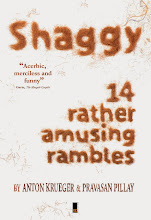
In literary theory the interlinking terms parody, satire, persiflage and pastiche all, in one way or another, denote the sending up or inversion of existing texts and textual norms. All the stories in Shaggy are satirical in nature; they are also parodies. Satire is derived from satura – a dish filled with various types of fruit, also connotating saturation and satiety. These texts are characterised by the humorous way in which a weakness of a person or a flawed aspect of society is sent up. Parodies render a well-known text, person or situation absurd, by imitating characteristics of these persons, texts or situations in a comical fashion.
In each Shaggy story a different persona becomes the narrator: a retired comic/comedian offering words of advice to a novice; a director of the SABC faced with the conundrum of dealing with a reduction of spending on programming from R4500 per minute to R1-50; a useless lecturer addressing his class and trying to salvage, in an extremely ingratiating way, both his job and his students’ future; a very stupid jailbird planning an escape, a wannabee Marxist activist desperately trying to justify his ultra-capitalist tendencies to his comrades; a restaurateur with an extremely weird addiction; a chairperson of a writing circle confessing about his sojourns into South African satanism; a Bollywood actress being interviewed and displaying every cliché about her trade; a young inventor trying to sell his South Africanised version of the Rubik’s cube; a literally obsessive whistle blower addressing his local police station, and a certain Prof Alex Fitzpatrick, who goes on a lengthy discourse about the number four, in the last sketch, aptly called “The Foreword”.
These stories vary from quips to sometimes absurd and side-splitting puns, jokes and send-ups. For example, in a footnote to the discourse about the number four, we learn about Professor Doctor Heinz Mannheim:
“Mannheim was awarded his professorship in Linguistics at Letz University at the remarkable age of seven, but a severe stutter prevented him from taking up lecturing duties. Instead, he was given free reign in his writing and research. The name Mannheim was consequently to become intimately associated with fields as diverse as Infant Biology, Water Mechanics, and the then nascent field of Hide-And-Go-Seek Studies. The latter occupied much of the pre-pubescent professor’s research hours” (p 127-8).
The satirist’s weapons are mainly under- or overstatement, irony, and sometimes sarcasm, and all these elements are found in abundance in these stories, but never in a condescending way. The cudgel or the rapier may be employed in getting the message across and, wisely, the rapier is mainly used.
If you like Monty Python, Pieter-Dirk Uys, Robert Kirby and especially Woody Allen (Getting Even), you will love Shaggy. It provided me with lots of hoots, and I hope it will do the same for you.






